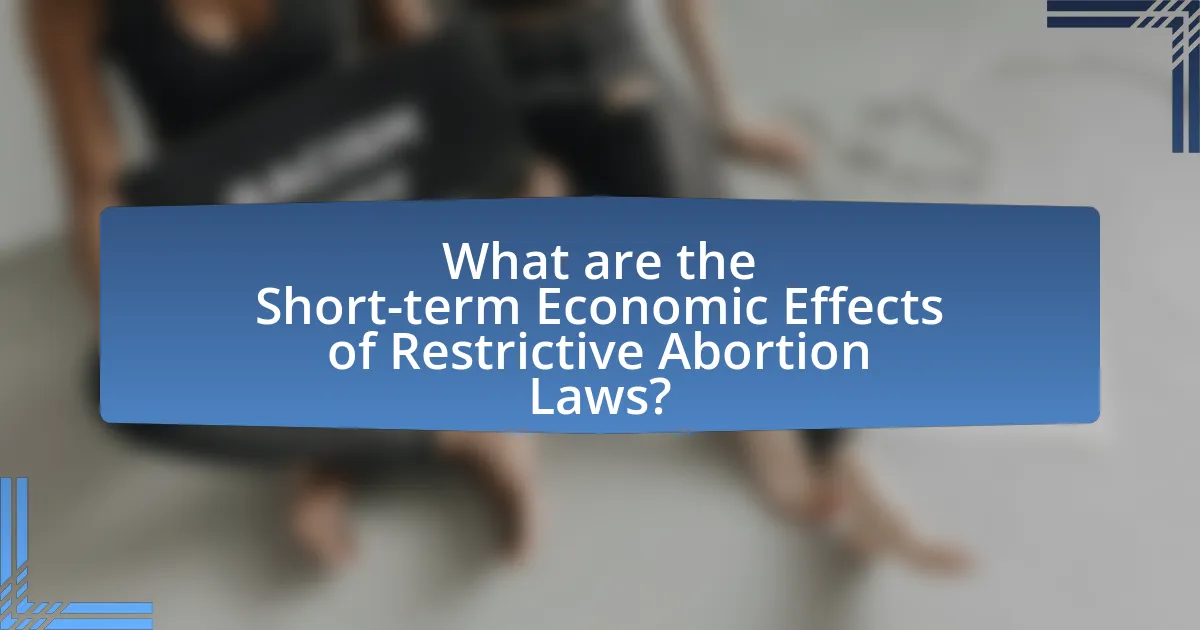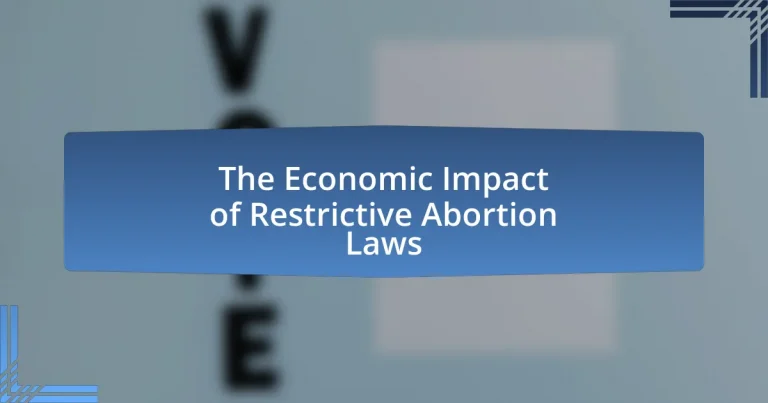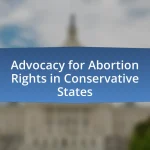Restrictive abortion laws are regulations that limit access to abortion services, significantly impacting women’s economic stability and overall societal health. These laws lead to increased healthcare costs, reduced workforce participation, and heightened financial hardship for women, particularly those denied abortions. Studies indicate that such restrictions correlate with higher poverty rates and diminished educational and career opportunities for women, perpetuating cycles of economic disadvantage. Additionally, the economic implications extend to public health systems and social services, as increased reliance on welfare programs and healthcare expenditures strain community resources. The article explores the multifaceted economic consequences of restrictive abortion laws, highlighting their effects on women’s health, productivity, and generational economic mobility.

What are Restrictive Abortion Laws and Their Economic Implications?
Restrictive abortion laws are regulations that limit access to abortion services, often imposing gestational limits, mandatory waiting periods, or requiring parental consent. These laws can lead to significant economic implications, including increased healthcare costs, loss of productivity, and negative impacts on women’s economic stability. For instance, a study by the Institute for Women’s Policy Research found that women denied abortions are more likely to experience economic hardship, with 73% of those denied reporting financial difficulties. Additionally, restrictive laws can strain public health systems by increasing the number of unsafe abortions, leading to higher healthcare expenditures.
How do restrictive abortion laws affect women’s economic status?
Restrictive abortion laws negatively impact women’s economic status by limiting their reproductive autonomy, which can lead to increased financial instability. When women are unable to access safe and legal abortion services, they may face unplanned pregnancies that can disrupt their education and career opportunities. For instance, a study published in the American Journal of Public Health found that women denied abortions were more likely to experience economic hardship, including increased reliance on public assistance and lower rates of employment. Additionally, research from the Guttmacher Institute indicates that women who can control their reproductive choices are more likely to achieve higher educational attainment and better job prospects, contributing to overall economic stability.
What is the relationship between access to abortion and women’s workforce participation?
Access to abortion significantly influences women’s workforce participation by enabling them to make informed choices about their reproductive health and career paths. Studies indicate that when women have access to abortion services, they are more likely to pursue higher education and remain in the workforce, contributing to economic growth. For instance, research published in the American Journal of Public Health found that women who can access abortion are more likely to participate in the labor market, with a 20% increase in workforce participation rates among those with access compared to those without. This relationship underscores the importance of reproductive rights in fostering economic opportunities for women.
How do restrictive laws impact women’s earning potential?
Restrictive laws significantly diminish women’s earning potential by limiting their access to reproductive healthcare and economic opportunities. For instance, studies indicate that women who face restrictions on abortion access are more likely to experience economic hardship, as unintended pregnancies can disrupt education and career advancement. According to research published in the American Journal of Public Health, women denied abortions are more likely to fall into poverty, with 74% of those denied reporting financial difficulties. This correlation illustrates how restrictive laws not only affect individual choices but also have broader implications for women’s economic stability and workforce participation.
What are the broader economic consequences of restrictive abortion laws?
Restrictive abortion laws lead to significant economic consequences, including increased healthcare costs, reduced workforce participation, and negative impacts on women’s economic stability. Studies indicate that women denied abortions are more likely to experience financial hardship, with a 2019 study published in the American Journal of Public Health showing that women who were denied an abortion were four times more likely to fall below the federal poverty line compared to those who received the procedure. Additionally, restrictive laws can result in higher public spending on social services due to increased reliance on welfare programs. The overall economic burden extends to society, as limiting access to reproductive healthcare can hinder women’s ability to participate fully in the labor market, ultimately affecting economic growth and productivity.
How do these laws influence healthcare costs for women?
Restrictive abortion laws significantly increase healthcare costs for women by limiting access to safe and legal abortion services, which often leads to higher expenses associated with unintended pregnancies. When women are unable to obtain abortions, they may face additional costs related to prenatal care, childbirth, and potential complications arising from carrying an unwanted pregnancy to term. For instance, a study published in the American Journal of Public Health found that women denied abortions were more likely to experience financial hardship, with 73% of those denied reporting that they struggled to afford basic living expenses. This financial strain can lead to increased reliance on public assistance programs, further escalating overall healthcare costs for women.
What is the impact on public health systems and social services?
Restrictive abortion laws significantly strain public health systems and social services by increasing the demand for maternal and child healthcare while limiting access to safe abortion services. This leads to higher rates of unintended pregnancies and unsafe abortions, which can result in increased maternal morbidity and mortality. For instance, a study published in the American Journal of Public Health found that states with more restrictive abortion laws experienced a 20% increase in maternal mortality rates compared to those with less restrictive laws. Additionally, social services face greater pressure to support families with unplanned children, leading to increased costs for welfare programs and child services. These dynamics create a cycle of resource allocation challenges, ultimately undermining the overall effectiveness of public health initiatives.
Why do restrictive abortion laws vary in their economic impact across different regions?
Restrictive abortion laws vary in their economic impact across different regions due to differences in healthcare access, socioeconomic conditions, and cultural attitudes. Regions with limited healthcare infrastructure may experience higher economic burdens as women face increased travel costs and lost wages when seeking services elsewhere. For instance, a study by the Guttmacher Institute found that states with more restrictive laws often see higher rates of unintended pregnancies, which can lead to increased public health costs and economic strain on families. Additionally, areas with lower socioeconomic status may struggle more significantly, as individuals in these regions often lack the financial resources to navigate the barriers imposed by such laws. Cultural attitudes towards abortion also influence the economic implications, as regions with strong opposition to abortion may experience greater stigma, impacting women’s workforce participation and overall economic productivity.
What factors contribute to regional differences in the economic effects of these laws?
Regional differences in the economic effects of restrictive abortion laws are influenced by factors such as local economic conditions, access to healthcare, demographic characteristics, and cultural attitudes. For instance, regions with higher poverty rates may experience more significant economic impacts due to increased healthcare costs and loss of workforce participation when access to abortion is restricted. Additionally, areas with limited healthcare infrastructure may face greater economic strain as women are forced to travel long distances for services, leading to increased costs and lost productivity. Demographic factors, such as age and education levels, also play a role; younger, less educated populations may be more adversely affected economically by restrictive laws. Cultural attitudes towards abortion can further exacerbate these differences, as regions with strong opposition to abortion may see more pronounced economic consequences due to stigmatization and reduced support for women facing unintended pregnancies.
How do cultural attitudes towards abortion influence economic outcomes?
Cultural attitudes towards abortion significantly influence economic outcomes by shaping policies that affect women’s reproductive rights and workforce participation. For instance, in societies where abortion is stigmatized, restrictive laws can lead to higher rates of unintended pregnancies, which in turn can limit women’s educational and employment opportunities. Research indicates that countries with more liberal abortion laws tend to have higher female labor force participation rates, contributing to overall economic growth. A study by the Guttmacher Institute found that access to abortion services is linked to improved economic stability for women, as it allows them to make informed choices about family planning and career advancement. Thus, cultural attitudes directly impact economic productivity and gender equality in the workforce.

What are the Short-term Economic Effects of Restrictive Abortion Laws?
Restrictive abortion laws can lead to immediate economic effects such as increased healthcare costs, reduced workforce participation, and negative impacts on women’s economic stability. For instance, when access to abortion is limited, women may face higher medical expenses due to complications from unsafe procedures or unintended pregnancies, which can strain public health resources. Additionally, studies indicate that restrictive laws correlate with decreased labor force participation among women, as they may need to take time off work for childbirth or childcare, thereby affecting overall economic productivity. Furthermore, research from the Institute for Women’s Policy Research shows that women who are denied abortions are more likely to experience economic hardship, which can lead to increased reliance on social services and a burden on the economy.
How do immediate economic impacts manifest in communities with restrictive laws?
Immediate economic impacts in communities with restrictive laws manifest through decreased access to healthcare services, leading to increased financial burdens on individuals and families. For instance, when abortion services are limited, individuals may incur higher costs traveling to distant facilities, which can strain local economies. A study by the Guttmacher Institute found that restrictive abortion laws can lead to a 10% increase in out-of-pocket expenses for reproductive health services, further exacerbating economic disparities. Additionally, communities may experience a decline in workforce participation as individuals face challenges in managing reproductive health, which can hinder overall economic productivity.
What are the effects on local businesses and employment rates?
Restrictive abortion laws negatively affect local businesses and employment rates by reducing workforce participation and consumer spending. When access to reproductive healthcare is limited, individuals, particularly women, may face increased economic instability, leading to lower employment rates. For instance, a study by the Institute for Women’s Policy Research found that states with more restrictive abortion laws experience higher rates of poverty among women, which directly impacts local businesses due to decreased purchasing power. Additionally, businesses may struggle to attract and retain talent in areas with stringent reproductive health policies, further exacerbating employment challenges.
How do these laws affect the demand for healthcare services?
Restrictive abortion laws decrease the demand for healthcare services by limiting access to reproductive health options. When such laws are enacted, individuals may face increased barriers to obtaining necessary medical care, leading to a decline in healthcare utilization. For instance, studies have shown that states with stricter abortion regulations experience a reduction in the number of abortions performed, which correlates with a decrease in overall healthcare service demand related to reproductive health. Additionally, the Guttmacher Institute reported that in states with restrictive laws, women often seek care in neighboring states, further illustrating the impact of these laws on local healthcare demand.
What are the implications for women’s health and productivity in the short term?
Restrictive abortion laws negatively impact women’s health and productivity in the short term by limiting access to safe reproductive healthcare. This restriction can lead to increased rates of unintended pregnancies, which may result in physical and mental health complications, including higher instances of maternal morbidity and mortality. Furthermore, when women are unable to make autonomous decisions regarding their reproductive health, their participation in the workforce diminishes, leading to decreased productivity. Studies indicate that women who face barriers to reproductive healthcare are more likely to experience economic instability, which further exacerbates health issues and limits their ability to contribute effectively to the economy.
How do restrictive laws lead to increased healthcare complications?
Restrictive laws lead to increased healthcare complications by limiting access to necessary medical services, which can result in delayed or inadequate care. For instance, studies have shown that regions with stringent abortion laws experience higher rates of maternal morbidity and mortality due to unsafe procedures and lack of timely interventions. According to a 2019 report by the Guttmacher Institute, states with more restrictive abortion laws saw a 10% increase in complications related to pregnancy and childbirth, highlighting the direct correlation between legal restrictions and adverse health outcomes.
What is the impact on mental health and its economic consequences?
Restrictive abortion laws significantly impact mental health, leading to increased rates of anxiety, depression, and post-traumatic stress disorder among individuals denied access to abortion services. Research published in the American Journal of Public Health indicates that women who are denied abortions are more likely to experience mental health issues compared to those who receive the procedure, with a 2017 study showing that 95% of women who sought abortions reported feeling relief after the procedure. The economic consequences of these mental health issues are substantial; the World Health Organization estimates that mental health disorders can lead to a loss of productivity, costing economies up to $1 trillion annually. Thus, restrictive abortion laws not only harm individual mental health but also impose significant economic burdens on society.

What are the Long-term Economic Consequences of Restrictive Abortion Laws?
Restrictive abortion laws can lead to significant long-term economic consequences, including decreased workforce participation and increased poverty rates. When individuals are denied access to safe and legal abortion services, they may face unplanned pregnancies that can hinder their educational and career opportunities. Research from the University of California, San Francisco, indicates that women who are denied abortions are more likely to experience economic hardship, with 74% of those surveyed living below the federal poverty line within four years of being denied. Additionally, restrictive laws can lead to increased healthcare costs associated with unintended pregnancies and childbirth, further straining public resources. Overall, the economic impact of such laws can perpetuate cycles of poverty and limit economic growth within communities.
How do restrictive abortion laws affect generational economic mobility?
Restrictive abortion laws negatively impact generational economic mobility by limiting women’s access to reproductive healthcare, which in turn affects their educational and economic opportunities. When women are unable to make choices about their reproductive health, they may face increased financial instability, leading to lower educational attainment and reduced workforce participation. Research from the University of California, San Francisco, indicates that women denied abortions are more likely to experience economic hardship, with 74% of those denied reporting that they were unable to afford basic living expenses. This economic strain can perpetuate cycles of poverty across generations, as children born into financially unstable environments often have limited access to quality education and resources, further hindering their economic mobility.
What is the long-term impact on children born into restrictive environments?
Children born into restrictive environments often face significant long-term impacts, including limited access to education, healthcare, and economic opportunities. Research indicates that these children are more likely to experience poverty, lower educational attainment, and poorer health outcomes compared to their peers from less restrictive settings. For instance, a study published in the American Journal of Public Health found that children born to mothers with limited resources due to restrictive laws are at a higher risk of developmental delays and chronic health issues. Additionally, the economic burden on society increases as these children may require more public assistance and healthcare services throughout their lives, further perpetuating cycles of disadvantage.
How do these laws influence educational attainment and career opportunities for women?
Restrictive abortion laws negatively influence educational attainment and career opportunities for women by limiting their reproductive autonomy and increasing economic instability. When women face barriers to accessing abortion services, they may be forced to carry unintended pregnancies to term, which can disrupt their education and hinder their ability to pursue career goals. Research indicates that women who have access to abortion are more likely to complete their education and achieve higher income levels; for instance, a study published in the American Journal of Public Health found that women denied abortions were more likely to experience economic hardship and less likely to achieve their educational aspirations. Thus, restrictive abortion laws can perpetuate cycles of poverty and limit women’s professional advancement.
What are the broader societal costs associated with restrictive abortion laws?
Restrictive abortion laws impose significant broader societal costs, including increased healthcare expenses, economic instability, and social inequality. These laws often lead to higher rates of unintended pregnancies, which can result in increased demand for public assistance programs and healthcare services. For instance, a study published in the American Journal of Public Health found that states with restrictive abortion laws experience higher rates of maternal mortality and morbidity, leading to increased healthcare costs for both individuals and the state. Additionally, restrictive laws disproportionately affect low-income individuals and marginalized communities, exacerbating existing social inequalities and limiting economic opportunities. The Guttmacher Institute reported that access to abortion services is linked to women’s economic stability, and restrictions can hinder their ability to participate fully in the workforce, ultimately affecting overall economic growth.
How do these laws contribute to poverty cycles in affected communities?
Restrictive abortion laws contribute to poverty cycles in affected communities by limiting women’s access to reproductive healthcare, which in turn affects their economic stability. When women are unable to make choices about their reproductive health, they may face unplanned pregnancies that can hinder their education and employment opportunities. For instance, studies show that women who are denied abortions are more likely to fall into poverty, with a 2017 study published in the American Journal of Public Health indicating that women denied abortions were four times more likely to experience economic hardship compared to those who received the procedure. This economic strain perpetuates a cycle of poverty, as families may struggle to provide for their children, leading to long-term socio-economic disadvantages within the community.
What is the relationship between restrictive laws and overall economic growth in a region?
Restrictive laws negatively impact overall economic growth in a region by limiting access to healthcare services, which can lead to poorer health outcomes and reduced workforce participation. For instance, studies have shown that regions with stringent abortion laws experience higher rates of maternal mortality and morbidity, which can diminish the productivity of women in the labor force. Additionally, the Guttmacher Institute reported that restrictive reproductive health policies can lead to increased economic burdens on families and communities, as they may face higher healthcare costs and lost income due to unintended pregnancies. This correlation indicates that such laws can stifle economic development by undermining the health and economic stability of the population.
What strategies can mitigate the economic impact of restrictive abortion laws?
Implementing comprehensive sex education and access to contraception can mitigate the economic impact of restrictive abortion laws. These strategies reduce unintended pregnancies, which in turn decreases the demand for abortions. Research indicates that states with comprehensive sex education programs have lower rates of teenage pregnancies and abortions, leading to improved economic outcomes for individuals and families. Additionally, increasing access to affordable contraception has been shown to empower individuals to make informed reproductive choices, further reducing the economic burden associated with restrictive abortion laws.
How can advocacy and policy changes improve economic outcomes for women?
Advocacy and policy changes can significantly improve economic outcomes for women by ensuring access to reproductive healthcare, which directly influences their ability to participate in the workforce. For instance, studies show that women who have access to abortion services are more likely to complete their education and secure better-paying jobs, leading to increased economic stability. According to research published by the Guttmacher Institute, women who are denied abortions are more likely to experience economic hardship, with 73% of those denied reporting that they were unable to afford basic living expenses. Therefore, effective advocacy for policy changes that protect reproductive rights can enhance women’s economic opportunities and overall financial well-being.
What role do community organizations play in supporting affected women economically?
Community organizations play a crucial role in supporting affected women economically by providing resources, advocacy, and financial assistance. These organizations often offer job training programs, financial literacy workshops, and access to employment opportunities, which empower women to achieve economic independence. For instance, a study by the National Women’s Law Center highlights that community organizations have successfully helped women access over $1 million in financial aid and job placements in the past year alone. Additionally, these organizations advocate for policies that protect women’s rights and access to reproductive health services, which are essential for maintaining economic stability.


